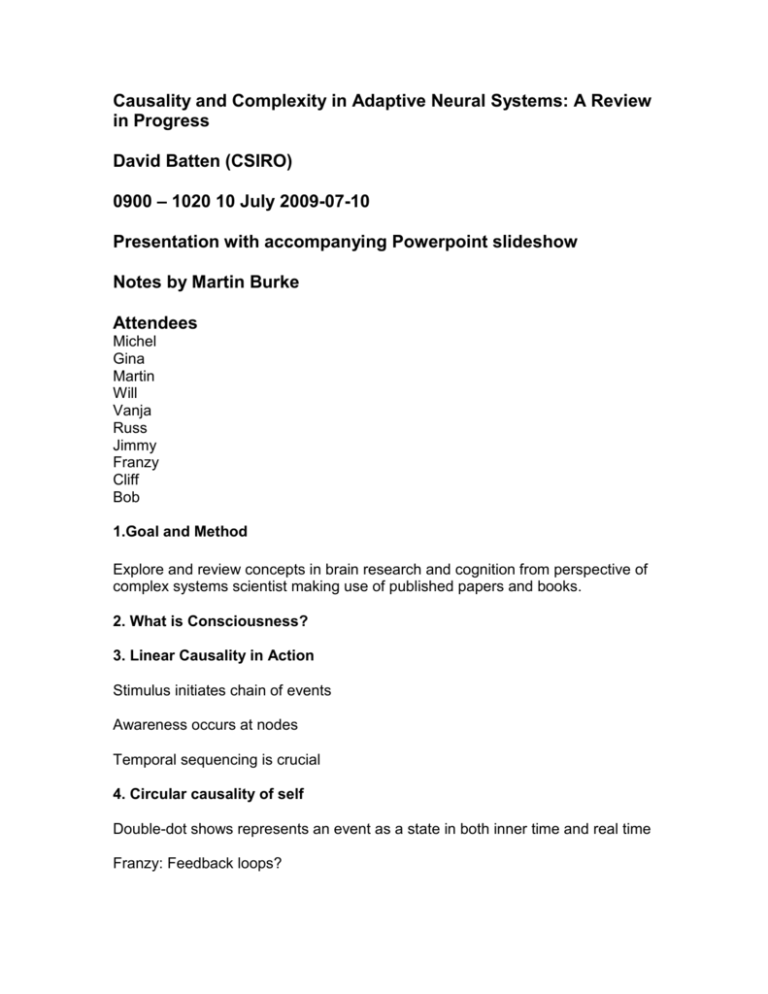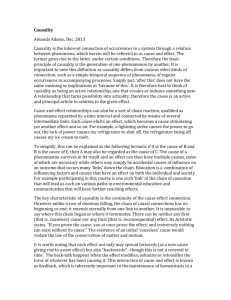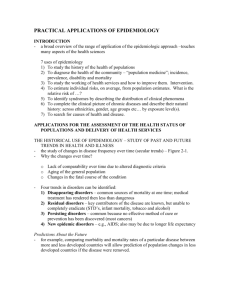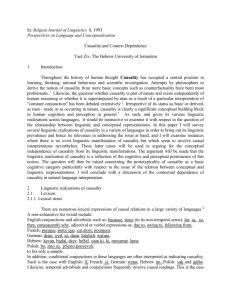Causality and Complexity in Adaptive Neural Systems: A Review in
advertisement

Causality and Complexity in Adaptive Neural Systems: A Review in Progress David Batten (CSIRO) 0900 – 1020 10 July 2009-07-10 Presentation with accompanying Powerpoint slideshow Notes by Martin Burke Attendees Michel Gina Martin Will Vanja Russ Jimmy Franzy Cliff Bob 1.Goal and Method Explore and review concepts in brain research and cognition from perspective of complex systems scientist making use of published papers and books. 2. What is Consciousness? 3. Linear Causality in Action Stimulus initiates chain of events Awareness occurs at nodes Temporal sequencing is crucial 4. Circular causality of self Double-dot shows represents an event as a state in both inner time and real time Franzy: Feedback loops? Michel?: Inner time and real time? Cliff/David/Will: Brain/mind/thoughts alter brain structure 5. Circular causality = systemic causality? John Finnigan has encouraged us to focus on examples Cliff: These cycles are everywhere not just in the brain. Bernard cells. CAS always based on such cycles. Franzy: Many of the concepts in this area are themselves not well defined and/or uncertain. Fascinating but about need to define new tools in order to promote shared understanding. Will: Ultimate example of emergence where “circuitry of neurons” generates cognition, understanding. Any glimpse into this will be helpful. Jimmy: Need to think about causality and causation differently. Pluralistic understanding/multiple viewpoints/multiple resolutions are essential to progress in practical situations. In some cases not even meaningful to talk causation. David: Spectrum of context always present. 4-5 standard examples may be useful in focusing are thinking and structuring our output to our funding sources. Try to think towards what we are need to deliver. Russ: Lots of work on causality seems to be attempts to force phenomena into single framework. Gina: This makes me think differently to how I did yesterday when looking at the “cyclinder diagram”. Is there a difference between the topology as an energy function and its structural features. Cliff: Toplogy just a math concept that describes “connectedness” on entities. Gina: Need to be careful that we know whether we are talking about the “object system” and its conception and representation. Circular causality express between interrelations between levels in a hierarchy. Circular and hierarchical relationships. 6. Some of Freemans conclusions Awareness: intentionality cannot be explained by linear causality Serlf-organisation: circular causality in a selforgansing brain is a useful concept in this concept. Cliff: Prigogine and Bannerman Franzy: “Hard problem of consciousness”? David: Literature is not clear on this. Russ: Some of the words used on this slide are not well defined/understood. Will: This is where we get into the concept of “emergence”. Franzy: We can deal with phenomena in the physical world but not in the “mind”. Jimmie. Ontological/epistemological issue. Are we getting simple enough models to explain what’s going on? Will: how do we know that we are not just bullshitting ourselves?! Jimmie: Models built up through combination of our studies and experiences. How do we know that we are modelling well? How established are the notions? How well do we understand the concepts labelled by these terms? Gina: does this help us address our CIN agenda? David: Perhaps too early to be able to answer this question. Russ: Awareness is the key. Gina: Can I be self-appointed moderator and say “can we get on with the talk”! Russ: No I want to carry on with this point! Subjectivity. Colour blinded example. New methods: similar pattern switching. Russ: “Spread of academics”! Cliff: Not necessarily generating any new mind! 7. New Method 1: S-O and Synergetics Synergetics and self-organisation of brain function and cognition (Haker, Kelso, Freeman, Lewis) Concept of circular causality should be discarded (Bakker) since it suggests it suggests interactions between entities that don’t really exist. 8. New Method 2: Attractor Neural Networks Hopfield introduced general concept. Associative memeory model based on formal neurons 9. New Methods 3: Causal Networks Neurons engage inb causal interactions with one another Neural systems can thus be analysed in terms of causal networks. Neurobitotic model of hippocampus has been developed. Causal networks may be useful in understanding characteristics of Consciousness. 10. Distinguishing Causal Interactions (Seth) Neural reference Context network (by backtrace) Causality analysis Causal core Etc Seth will be attending next workshop. 11. Granger Causality Granger is a Nobel laureate in ecometrics Method for determining whether one time series is useful in forecasting another Statistical not physical Causality canbe unidirectional or reciprocal Many extensions to suit neurodynamics Becoming accepted as a promising method for the future. Granger casual relationships can be represented as a directed graph. 12. Lakoff on Frames and Metaphors Frames are mental models of limited scope. Frames and metaphors define our common sense. Thinking in frames and metaphors give rise to inferences that don’t fit the laws of logic or deductive rationality. Jimmie: “Truth” Influencing populations through storytelling to create biased beliefs. An important recognition. Martin: Lakoff argues that metaohors give succinct descriptions of systemic properties and emotional connotations. (Metaphors We Live By, Lakoff and Johnson) 13. Two Competing Worldviews As many worldviews as humans. Some crop up repeatedly in the social sciences: Sheep and explorers Imitators and innovators Cartesians and stochasts Conservatives and progressives They correspond to 2 extremes in risk-taking Lakoff: 2 parenting models -> 2 worldviews Does Lakoff really have evidence? 14. Conclusions for our Workshop Series Causality and complexity have been discussed at length in neuroscience field Thus possible focus as a sub-theme in future workshops and deliverables Thought leaders: Freeman Haken Bressler Seth Neuroscience Institute (San Diego) Lakoff Tough area. Do they have any methodologies that we could make use of? Jimmie: DARPA doing multi-trillion node brain modelling. May not be taking evolutionary design approach. Can look into on our behalf. 15. Thank You. Discussion (1020 Cliff: Thousands of brain modellers out there. Check with Dave Green at Wogga if we need better info. Cliff: Social vs ABM. Someone must be thinking of this but who? Search on keywords: Protein computing; neural axons. Russ: AAAI 2009 Symposia each Spring and Fall. This year in Arlington. Russ: Wiki cs.calstatela.edu








